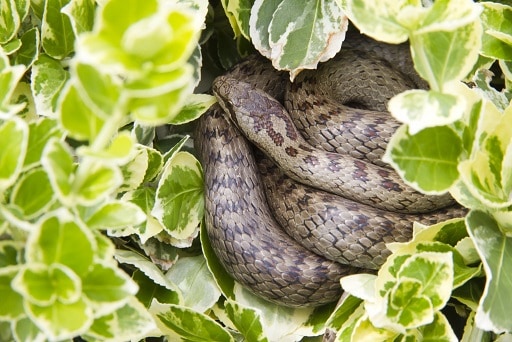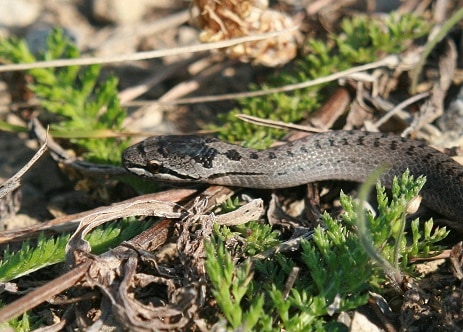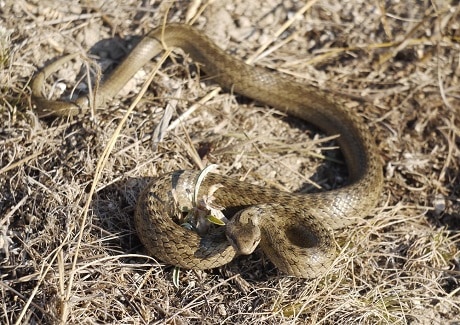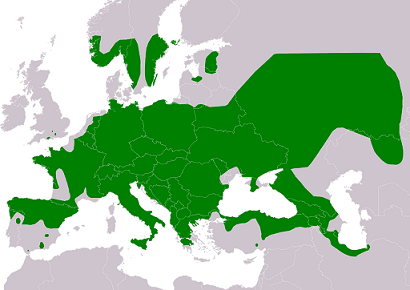| 1 | Britain’s secret 3rd snake |

Everyone in Britain above age five know about the island’s two snake species, the adder and the grass snake. They know that one is venomous and one is harmless, but few know of the island’s secret third snake: the smooth snake. This species is restricted to 5 confirmed countries, and lives in a narrow heathland habitat, particularly Surrey and Dorset in the south.
The smooth snake is 70cm long, with a slim body. There are few standout patterns, with an olive-brown colour and faded black patches designed for camouflage. This makes it hard to distinguish from the grass snake, but look closer, and you’ll see a unique butterfly shaped marking on the back of its head. A second unique marking is a black line, beginning at the neck and continuing along its face right through the eye.
Grass snakes meanwhile, have a black marking below the eye. Adders usually have distinct zigzag markings, but the tricky part is that consistent beige adders also appear. However, the adder has vertical pupils, while a smooth snake’s are perfectly round.
| 2 | Almost impossible to find |

The smooth snake is so secretive that dedicated research teams can go 3 years without finding one. The thick, dense heathlands they live in can make them almost invisible.
Smooth snakes live not just in heathland, but heathland with a mature mossy base averaging at 30cm in thickness. The exploring scientists up above probably have a wonderful view, stretching for miles and miles to the coast. But down below, the smooth snake inhabits a very different world: a neverending labyrinth of wall-like vegetation, and winding roots that look as thick as tree trunks.
Additionally, when trying to warm their bodies, they rarely bask in open sunlight. Smooth snakes prefer to bask while intertwined with vegetation instead. All this makes finding them an absolute nightmare. But the advantage to this secrecy is that some colonies might have been missed; some believed they live in Berkshire and Wiltshire as well. In the spots where they do survive, smooth snakes can be extremely numerous.
| 3 | Sticks to a cosy home base |

Smooth snakes are a long-lived snake, sometimes reaching nearly 30 years. Mothers breed at a very slow pace, sometimes only every 3 years. Smooth snakes are like humans in that each has a miniature base, which they might venture out from, but always return to each day. This “house” can be a mammal hovel, a sand lizard (one of their main prey) burrow, or within deep root structures. In the 1990s, scientists radio-tracked individual smooth snakes, and found that some stuck to the same mini base for years.
On the average day, the smooth snake moves no more than half a metre. But on others they’ll embark upon journeys of hundreds of metres, through the thick heathland obstacle course. These quests are almost certainly in search of new prey.
Back in the 1910s, smooth snakes were regarded as highly intelligent. “It is one of the most intelligent of snakes, second to none in educability; it can be trained to feed in the hand of its master“, said G.A. Boulenger in “The Snakes of Europe”.
| 4 | Weakened by WW2 |
Smooth snakes are an endangered snake on British soil. The heathland they inhabit has shrunk by 85% over the last 200 years, being replaced by cow fields and new housing estates. For example, Bournemouth is one of Britain’s glitziest sea towns today, where the beaches are packed full on a hot July day. But 150 years ago it was a small village, and the surrounding countryside was reportedly swarming with smooth snakes. Rumour has it that the locals were merciless in clubbing the snakes to death.
World War 2 also dealt a blow, starting in 1942 when Dorset heathland was used as a decoy for Luftwaffe bombers. Pipes were filled with paraffin and tar, which burst into flame and fooled German pilots into thinking they’d struck important military targets.
2 years later, the heathlands were already scarred by fire, and so the huge influx of Canadian and American troops decided to make them their training grounds for D-Day landings (particularly Studland heath and Canford heath). With them came heavy, trampling war vehicles.
| 5 | Sightings continue to decline |

One of the smooth snake’s main strongholds in southern England is Wareham forest, which has numerous open patches heavy in heathland. From 2002 to 2010, sightings in the forest plummeted, with a smaller but significantly decline from 2010 to 2018.
Some strange “coincidences” were blamed for the decline. In 1998, cattle was introduced onto the heathland, with the noble goal of managing grasses for conservation. In 2002, conservationists decided to fill in the artificial drainage channels in the heath pockets. The goal was again a noble one, restoring the old wet mire to create an untouched habitat, but the resulting pools of water may have bogged the local smooth snakes down.
Similar tales have happened all over southern England, but the fightback has now started in earnest. In 2019, the National Lottery awarded £412,000 for the future protection of smooth snakes. The money would go towards hiring hundreds of volunteers, training them to ID smooth snakes, training them in mapping, and conserving the heathland habitat itself.
| 6 | Diet: lizards and slow worms |
Fellow reptiles are the smooth snake’s main food source, particularly the endangered sand lizard. This is the UK’s second rarest reptile, and is rare for the same reason as smooth snakes: a restricted habitat of sandy heathland. The two often duel in these isolated strongholds, and at 20cm versus the smooth snake’s 70cm, the sand lizard fits down nicely. Sand lizards dig burrows in the soft sand, and smooth snakes are sometimes found in those empty burrows, probably after eating the inhabitants.
The common lizard, meanwhile, is a slightly smaller 15cm. This is the most northerly dwelling non-marine lizard in the world, and stretches from the UK to Sakhalin off the far-east coast of Russia. The same Wareham forest study found that as smooth snakes fell post 2002, the local common lizards suddenly regenerated.
Smooth snakes also dine on the slow worm, the final of the UK’s 6 reptile species (3 snakes, and 3 more), which is often mistaken for a snake. Additionally, the pigmy shrew made up 20.5% of prey in the Wareham forest study, next to 38.5% for the common lizard.
| 7 | Sneaks up behind its prey |
Smooth snakes are also able to eat the venomous adder, as long as the adder’s length doesn’t exceed 30cm. To hunt, smooth snakes opt for a state of the art hybrid warfare strategy, midway between foraging and ambush. At first, smooth snakes wait patiently in the thick heather, before an oblivious shrew or sand lizard wanders past. The smooth snake then enters foraging mode, and stalks its prey silently through winding corridors of heather.
Smooth snakes don’t pursue their prey at high speeds, but pounce on them the moment they edge close enough. They then hold the lizard with their non-venomous, yet razor sharp backwards-curving teeth.
Smooth snakes aren’t a traditional constrictor, but wrap around a couple of body coils to keep their prey in an unbreakable snake jail. Then they orient the prey headfirst, their preferred method of swallowing. Smooth snakes are quite flexible, and can swallow prey alive or dead (the prey, not the snake).
| 8 | Vicious if pushed |

The smooth snake is poor at self defence, even compared to the non-venomous grass snake. The latter has an amazing play dead strategy where it goes completely limp, and lolls its tongue out lifelessly. The smooth snake lacks this. Grass snakes emit a foul odour, to force a hungry predator to leave in disgust. Smooth snakes have this weapon, but in a milder, more tolerable form.
Smooth snakes were long considered to be mute, as they almost never hiss. The hisses they do make are short and quiet. Their main strategy for dodging predators is camouflage, turning their dull and nondescript scales to their advantage.
That said, the smooth snake has a tendency to flip 180 degrees and viciously bite anybody that picks them up. They have a tendency to snap onto a finger, refusing to dislodge themselves, even if handled gently. Their natural predators include classic English characters such as pheasants, foxes and badgers.
| 9 | Smooth for a good reason |
The smooth snake isn’t smooth as mere gimmick. There’s a purpose behind everything, and it revolves around their heather habitat. Grass snakes slither around in ponds and field edges, and can be as rough as they want. But smooth snakes are constantly crawling through a tangled vegetation maze, and the last thing they want is for their scales to get caught, constantly forcing them to reverse and readjust.
The active season for smooth snakes is March to October. Mothers lay live young, which come in batches of 4-14 with a mean of 5, normally in August or September. The younglings are born in a thin membrane, which they tear out of instantly. Young smooth snakes have a poor survival rate, preyed upon by birds, and will stick together in a ball for their first few days. A newborn smooth snake is 15cm long, and with its thinness is an almost perfect match for the shape of a pencil. Newborns are a similar dull brown, but slightly darker than adults.
Colour is also a gender ID sign, as male smooth snakes have a colourful orange patch on their throat which females lack.
| 10 | Beyond British shores |

They might be on their last legs in Britain, but smooth snakes have a vast range in Eurasia. They exist from Italy to the Moscow countryside, and even the northern parts of Iran. They’re believed to be extinct in Denmark, but with their secretive nature they may still cling on, as there were only ever 6 sightings from 1870-1914 originally.
For decades, the smooth snake was believed to have three subspecies. There was Coronella austriaca acutirostris in Spain and Portual, a tiny enclave of C. a. fitzingeri in Sicily, and then C. a. austriaca everywhere else (including Britain).
But with such a giant range, it would be amazing if there wasn’t more, and a 2019 study found 14 different genetic clades across Eurasia. This included 3 within western Europe, 3 in the Iberian peninsula, 1 in the Balkans, and 2 in Iran. The genetic chasms were deep, and the Iranian versions were believed to have separated back in the Miocene era. Time will tell how many subspecies finally coalesce.
| !! | BONUS: Cannibalism |
Even though smooth snakes are mostly a calm and humble species, they have a dark side, specifically a brutal tendency to eat each other. In September 2018, scientists were scouting Wareham Forest in the UK (a series of pine plantations), when they found two smooth snakes coiled around each other. Originally, they assumed they were mating, but as the minutes unfolded, they noticed that the male was swallowing the female headfirst. The male measured 56cm versus 51cm for the female. The scientists noticed that their body condition was poor, thin and scraggly, pushing the male to desperate measures.
Smooth snakes have also eaten each other in captivity, making it risky to place them together. In the wild, it definitely happens, but studies disagree as to how often. A British study estimated that fellow smooth snakes were 0.1-0.3% of calories, but an Italy study estimated 1.7-6.25%, and a Belarusian study 9.1-10.3%.
